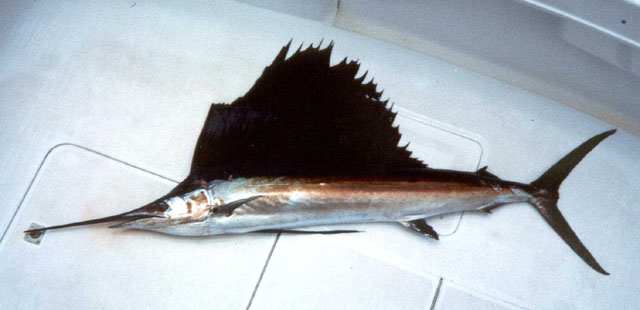| Istiophoridae (Billfishes) |
| 315 cm TL (male/unsexed); max.weight: 58 kg; max. reported age: 4 years |
|
pelagic-oceanic; depth range 0 - 200 m, oceanodromous |
| Atlantic Ocean: in tropical and temperate waters approximately 40°N in the northwest Atlantic, 50°N in the northeast Atlantic, 40°S in the southwest Atlantic, and 32°S in the southeast Atlantic. Migrating to Mediterranean Sea, mostly based on juvenile specimens. Highly migratory species, Annex I of the 1982 Convention on the Law of the Sea (Ref. 26139). Some authors recognize a single worldwide species, Istiophorus platypterus (Shaw 1792) but we follow Nakamura 1990 (Ref. 10820) retaining the usage of Istiophorus platypterus for the Indo-Pacific sailfish and Istiophorus albicans for the Atlantic sailfish in recognition of differences between them. |
|
Dorsal spines (total): 0-0; Dorsal soft rays (total): 48-53; Anal spines: 0-0; Anal soft rays: 9-12; Vertebrae: 24-24 |
| Usually found in the upper layers of warm water above the thermocline, but also capable of descending to rather deep water. Often migrate into near-shore waters. Occasionally form schools or smaller groups of 3 to 30 individuals, but often occur in loose aggregations over a wide area. Feed mainly on small pelagic fishes but also takes bottom-dwelling organisms. Females grow larger (Ref. 4770). Utilized fresh, canned and frozen; eaten steamed (Ref. 9987). |
|
Not Evaluated
(Ref. 96402)
|
| harmless |
|
Source and more info: www.fishbase.org. For personal, classroom, and other internal use only. Not for publication.
Page created by Jen, 05.08.02,
php script by kbanasihan 06/09/2010 ,
last modified by
dsantos, 20/08/10

